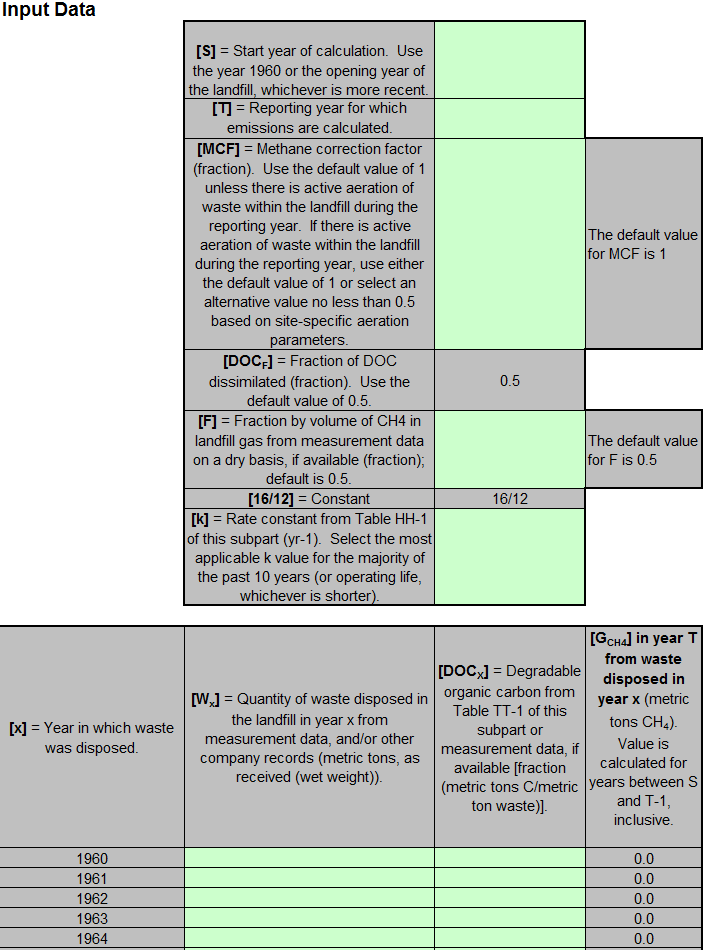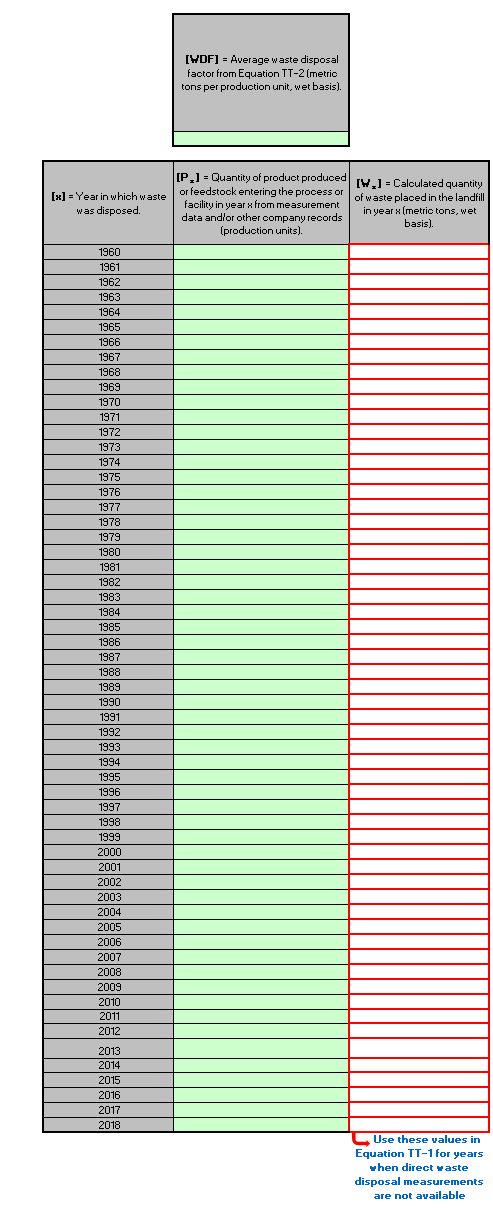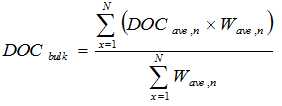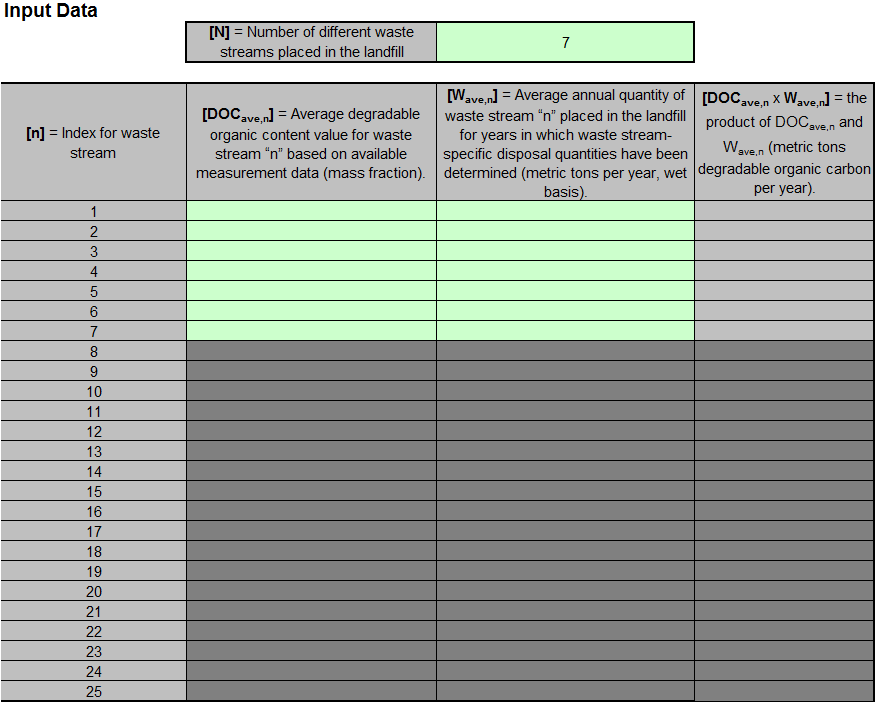These optional spreadsheets are provided to assist reporters in calculating emissions and in keeping records of these calculations.
Reporters are required to keep records of these calculations under 40 CFR 98.3(g) and additional subpart-specific provisions, but are not required to use these spreadsheets or to submit any spreadsheets to EPA.
Overview
This help page provides guidance for working with the supplemental Subpart HH calculation spreadsheets. The guidance provides step-by-step instructions for the following tasks:
- Downloading a Calculation Spreadsheet
- General Information on Using a Calculation Spreadsheet
- Using the Equation TT-1 Calculation Spreadsheet
- Using the Equation TT-2 Calculation Spreadsheet
- Using the Equations TT-3, TT-4a, and TT-4b Calculation Spreadsheet
- Using the Equation TT-5 Calculation Spreadsheet
- Using the Equation TT-6 Calculation Spreadsheet
Downloading a Calculation Spreadsheet
Calculation spreadsheets for Subpart TT may be downloaded by clicking one of the links in the first column of the table below. Users may also jump to instructions for each calculation spreadsheet by clicking one of the links in the fourth column.
Calculation Spreadsheet | Calculation | Spreadsheet Applicability | Instructions |
|---|---|---|---|
Modeled methane generation rate in reporting year | All landfills | ||
Equation TT-2 Calculation Spreadsheet.xls | Waste disposal rate per unit of production or unit of throughput | All landfill waste streams | |
Equation TT-3, TT-4a, TT-4b Calculation Spreadsheet.xls | Quantity of waste placed in the landfill in year x (wet basis) | Landfills where historical waste disposal quantity data are not readily available | |
Equation TT-5 Calculation Spreadsheet.xls | Weighted average bulk DOC value (if Equations TT-4a or TT-4b are used) | All landfills | |
Methane generation, adjusted for oxidation, from the landfill in the reporting year | All landfills |
The newly collected data elements for RY2012 enable emissions calculations to be executed within e-GGRT for certain subpart equations. As a result, affected Optional Calculation Spreadsheets will not be necessary for the following emissions calculation equations:
- Equation TT-1
- Equation TT-6
Please note that you may use the Optional Calculations Spreadsheets if you would like, but it is not necessary anymore (noted as "Archived" in the above table).
General Information on Using a Calculation Spreadsheet
The guidance provided in this section applies to each of the calculation spreadsheets for Subpart TT. Additional guidance is provided for each individual calculation spreadsheet in the sections below.
Color Coding
The calculation spreadsheets contain green input cells, gray informational cells and red-bordered results cells. Users should use green input cells to enter all data specific to their facility, unit, or process. As you progress through a reporting form, you may notice some green input cells changing to black deactivated cells. Black deactivated cells are not applicable to the user based on previous data entries in the form. Users should not enter data into these cells. Gray informational cells contain parameter names, column and row headings, equation constants and subtotals. Calculation results are displayed in red-bordered results cells. Values displayed in red-bordered cells with yellow fill should be entered into another cell within the same calculation spreadsheet or in another calculation spreadsheet as directed by spreadsheet instructions. Values displayed in red-bordered cells with white fill should be entered directly into e-GGRT. All cells that are not green input cells are locked and cannot be modified.
Green input cell (data entry) | |
Black deactivated cell (not applicable, no data required) | |
Gray informational cells (locked) | |
Red-bordered/yellow fill results cells (enter into another spreadsheet) | |
Red-bordered/white fill results cells (enter into e-GGRT) |
Stop and Warning Messages
The calculation spreadsheets will display a stop message if the user enters a value that is invalid or a warning message if the user enters a value outside the EPA estimated range for a particular data element. For invalid data entries, the stop messages will not allow a user to proceed and the user must reenter valid data before moving forward. For data entries that are outside the EPA estimated range for a particular data element, the warning messages will allow a user to proceed if the user deems the entered value to be accurate.
Using the Equation TT-1 Calculation Spreadsheet
This calculation spreadsheet will calculate the modeled CH4 generation for each waste stream disposed of in the landfill and then sum the CH4 generation rates for all waste streams disposed of in the landfill to get the total annual CH4 generation rate of the landfill for the reporting year.
(Equation TT-1) |
|---|
Begin by entering the facility name, your name, the unit name or identifier, the reporting period, and any additional comments in the green input cells of the general information table located immediately below the equation in the calculation spreadsheet. This is for your records.
Next, enter the requested information in the green input cells in the Input Data table. Note that if data are not available for the Methane Correction Factor (MCF) and the Fraction of Degradable Organic Carbon (DOCF), enter their respective default values of 1 and 0.5.
The calculated value will be displayed in a red-bordered cell with yellow fill at the bottom of the spreadsheet. This value should be entered in the Equation TT-6 Calculation Spreadsheet for this landfill.
Using the Equation TT-2 Calculation Spreadsheet
For each waste stream disposed of in the landfill, the calculation spreadsheet will calculate the average waste disposal rate per unit of production or unit throughput using all available waste quantity data and corresponding production or processing rates for the process generating that waste or, if appropriate, the facility.
(Equation TT-2) |
|---|
Begin by entering the facility name, your name, the unit name or identifier, the reporting period, and any additional comments in the green input cells of the general information table located immediately below the equation in the calculation spreadsheet. This is for your records.
Enter the first year in which disposal production/throughput data are available and the first year that GHG emissions from this industrial landfill must be reported. Then, input the necessary quantities in the green input cells for the corresponding years.
The calculated value will be displayed in a red-bordered cell with yellow fill at the bottom of the spreadsheet. This value should be entered in the Equation TT-3 Calculation Spreadsheet for this landfill.
Using the Equations TT-3, TT-4a, and TT-4b Calculation Spreadsheet
For each waste stream disposed of in the landfill, you must calculate the waste disposal quantities for historic years in which direct waste disposal measurements are not available using historical production data and Equation TT-3.
(Equation TT-3) |
|---|
For any year in which historic production or processing data are not available (i.e., historic waste quantities cannot be estimated using Equation TT-3), calculate an average annual bulk waste disposal quantity using either Equation TT-4a when data are available consecutively for the most recent disposal years or Equation TT-4b of this section when data are available for sporadic (non-consecutive) years.
(Equation TT-4a) | |
|---|---|
(Equation TT-4b) |
Begin by entering the facility name, your name, the unit name or identifier, the reporting period, any additional comments, and the equation you wish to use (TT-3, TT-4a, and TT-4b) in the green input cells of the general information table. This is for your records.
Using the Equation TT-3
For Equation TT-3, enter the average waste disposal factor from Equation TT-2, and then input the waste quantities corresponding to each year. Those quantities will be multiplied by the was disposal factor for use in Equation TT-1 for years when direct waste disposal measurements are not available.
Using the Equations TT-4a and TT-4b
For Equation TT-4a, enter the requested information in the green input cells. Note that this equation should only be used when when data are available consecutively for the most recent disposal years.
Use the final value in the red bordered box in Equation TT-1 for years when waste disposal quantities are not available from measurement data or from Equation TT-3.
For Equation TT-4b, enter the requested quantity information in the green input cells. Note that this equation should only be used when when data are available for sporadic (non-consecutive) disposal years.
Use the final value in the red bordered box in Equation TT-1 for years when waste disposal quantities are not available from measurement data or from Equation TT-3.
Using the Equation TT-5 Calculation Spreadsheet
For years for which bulk waste disposal quantities are determined, you must calculate the weighted average bulk DOC value according to the following: Calculate the average DOC value for each waste stream as the arithmetic average of all DOC measurements of that waste stream that follows the methods provided in 98.464(b) (generally, this will include only the DOC values determined in the first year in which GHG emissions from this industrial waste landfill must be reported), calculate the average annual disposal quantity for each waste stream as the arithmetic average of the annual disposal quantities for each year in which waste stream-specific disposal quantities have been determined, and calculate the bulk waste DOC value using Equation TT-5 of this section.
(Equation TT-5) |
|---|
Begin by entering the facility name, your name, the unit name or identifier, the reporting period, and any additional comments in the green input cells of the general information table located immediately below the equation in the calculation spreadsheet. This is for your records.
Next, enter the number of waste streams at the landfill in the green cell, and then input the average DOC and the average annual quantity of waste (for years in which waste stream-specific disposal quantities have been determined) for each corresponding waste stream.
The calculated value will be displayed in a red-bordered cell with yellow fill at the bottom of the spreadsheet. This value should be entered in the Equation TT-1 Calculation Spreadsheet for years when waste disposal quantities are not available from measurement data or from Equation TT-3.
Using the Equation TT-6 Calculation Spreadsheet
The calculation spreadsheet will calculate the CH4 generation (adjusted for oxidation) from the landfill in the reporting year. For landfills that do not have landfill gas collection systems, the annual CH4 emissions are equal to the annual CH4 generation (adjusted for oxidation).
(Equation TT-6) |
|---|
Begin by entering the facility name, your name, the unit name or identifier, the reporting period, and any additional comments in the green input cells of the general information table located immediately below the equation in the calculation spreadsheet. This is for your records.
Next, enter the requested information in the green input cells in the Input Data table, including the result of Equation TT-1 as calculated using the Equation TT-1 Calculation Spreadsheet.
The calculated value will be displayed in a red-bordered cell with white fill at the bottom of the spreadsheet. This value should be entered into e-GGRT for this landfill.


























